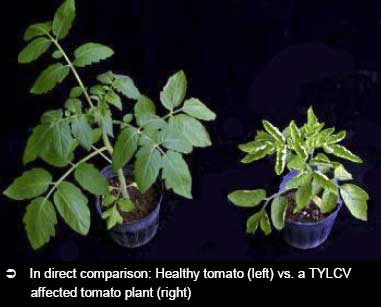Tainan, Taiwan
February 20, 2009
Source:
AVRDC - The World Vegetable
Center Newsletter
 Tomato
(Solanum lycopersicum) is a high value crop and a
valuable source of vitamin A in human diets. However, yields in
the tropics average less than 15 t/ha, far lower than those in
developing countries in temperate areas. Diseases are a major
cause of low tomato yields in the tropics; especially Tomato
yellow leaf curl virus (TYLCV) and bacterial wilt (BW). TYLCV is
spread by the sweet potato whitefly after it feeds on infected
plants. Farmers often spray pesticides to control the disease,
causing harm to themselves and the environment. The BW pathogen
(Ralstonia solanacearum) lives in the soil and infects tomato
and many other plant species. It causes plants to wilt and die,
often just before harvest. BW is so severe in some regions that
farmers are not able to grow tomato at all. Tomato
(Solanum lycopersicum) is a high value crop and a
valuable source of vitamin A in human diets. However, yields in
the tropics average less than 15 t/ha, far lower than those in
developing countries in temperate areas. Diseases are a major
cause of low tomato yields in the tropics; especially Tomato
yellow leaf curl virus (TYLCV) and bacterial wilt (BW). TYLCV is
spread by the sweet potato whitefly after it feeds on infected
plants. Farmers often spray pesticides to control the disease,
causing harm to themselves and the environment. The BW pathogen
(Ralstonia solanacearum) lives in the soil and infects tomato
and many other plant species. It causes plants to wilt and die,
often just before harvest. BW is so severe in some regions that
farmers are not able to grow tomato at all.
“Disease-resistant varieties are the most effective, cheapest,
and easiest way to control diseases to benefit
small-scale farmers, but resistance is often unstable and does
not work equally well against all pathogen strains or in all
environments,” says Dr. Peter Hanson, Tomato Breeder and the
Center’s Global Theme Leader for Breeding. “Together with
partners from the University of Hannover and funded by Deutsche
Gesellschaft für Technische Zusammenarbeit (GTZ) we are
developing tomato lines for the tropics with stable BW and TYLCV
resistance. We identify and use resistance genes from wild and
cultivated tomato species and we apply molecular markers to
develop disease resistant tropical tomato varieties.”
The use of molecular markers increases the efficiency of plant
breeding for disease resistance by facilitating the selection of
multiple resistance genes. Molecular markers have been applied
to select tomato populations for two TYLCV resistance genes.
Hybrids with TYLCV resistance genes from this project
demonstrated promising
resistance in north India during trials in October 2007. Hybrids
and inbred lines with multiple TYLCV resistance genes,
resistance to BW, heat tolerance, and good fruit quality have
been under evaluation in 2008 trials in India, Vietnam,
Cambodia, Thailand, Mali, and Niger. Additional TYLCV and BW
genes for resistance are being
mapped for future breeding activities.
“Improved varieties will benefit small-scale producers and can
create additional employment opportunities along the commodity
chain,” says Hanson. “Tomato varieties resistant to TYLCV and BW
will increase yield by 30%
or more and allow farmers to reduce pesticide applications for
whitefly control, reducing their production costs and improving
product and environmental safety.” Rich in micronutrients,
tomatoes also help improve the nutritional status of consumers
in the tropical lowlands beyond the typical limits of tomato
cultivation. The tomato varieties developed through the project
are international public goods and will be disseminated by AVRDC
– The World Vegetable Center through public and private sector
institutions worldwide. |
|